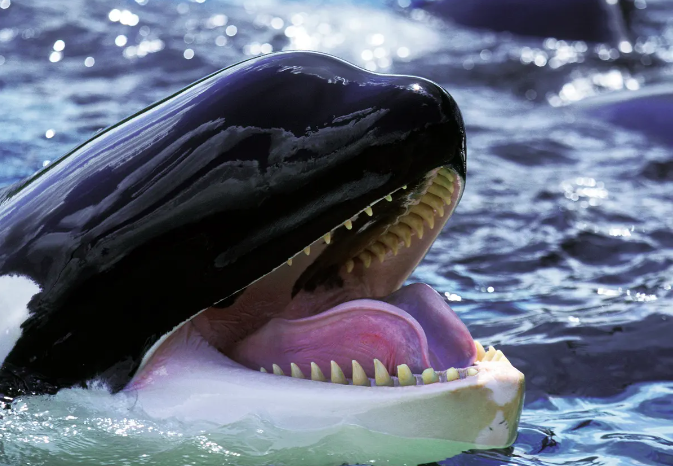It is widely recognized that parrots and other avian species can be taught to mimic human speech. However, a fascinating development has emerged where killer whales have joined the ranks of mammalian contenders, posing a unique competition to their feathered counterparts.
Wilkie The Speaking Killer Whale
Killer whales, the dominant predators of the ocean, possess remarkable qualities akin to the majestic big cats of the seas. Renowned for their remarkable swiftness, strength, and agility, these awe-inspiring marine mammals also exhibit a lesser-known trait—remarkable intelligence.
A study conducted by the esteemed Royal Society in January 2018 shed light on the exceptional ability of killer whales to mimic sounds, even including human words. The focus of the research was Wilkie, a captive killer whale residing at Marineland, an aquarium in Antibes, France. At the age of 14, Wilkie shares her habitat with her calf.
Wilkie demonstrates a capacity to learn words through exposure to her trainers’ spoken language. Among her repertoire are words like “hello,” “one,” “two,” and “three.” Astonishingly, she can even vocalize “Amy,” the name of one of her trainers. The study revealed that Wilkie exhibits a remarkable aptitude for swiftly acquiring new sounds, often mastering them in under ten attempts.
Despite the absence of vocal cords, the whistles, clicks, and distinct utterances produced by Wilkie closely resemble the words she has been exposed to, offering clear evidence of her ability to imitate human language.
Killer Whale Dialects

In the dark depths of the underwater realm they call home, whales rely more on sound than their vision. Researchers have discovered that different pods of wild killer whales have their own unique “language,” or dialects, and these distinct accents can be learned and imitated by other groups.
When killer whales produce sounds, they utilize a specialized structure called the “phonic lips,” connected to their blowhole. These sounds are then amplified by a region on their head known as the “melon.”
Sound serves multiple purposes for killer whales. It serves as a means of communication, allowing them to convey messages to one another. Additionally, these majestic creatures use sound for navigation and hunting. By listening to the echoes produced by their own sounds, the whales can create a mental image of their surroundings, a fascinating process known as echolocation.
Big Brains
With brains ranking second in size among all creatures, killer whales possess remarkable intellect. Weighing around 12 to 15 pounds (5.4 to 6.8 kilograms), their brains are approximately five times larger than those of humans, whose average brain weight is about 2.7 pounds (1.2 kilograms).
While brain size alone doesn’t guarantee intelligence, the most intelligent animals generally exhibit larger brains relative to their body size.
Survival for killer whales relies not solely on strength and speed. These magnificent creatures adopt a communal lifestyle, living and hunting together, where intelligence plays a crucial role. Their ability to communicate with other group members is vital in this way of life.
To conclude, killer whales possess a fearsome reputation as formidable ocean predators, yet there are no documented instances of them fatally attacking humans in the wild.
Nonetheless, if you find yourself in the ocean and hear someone counting “one, two, three” behind you, it might be wise to start swimming.
